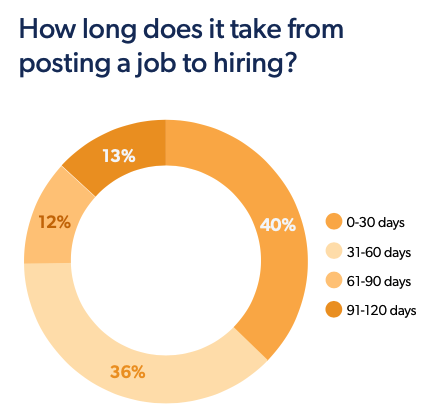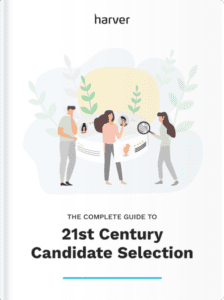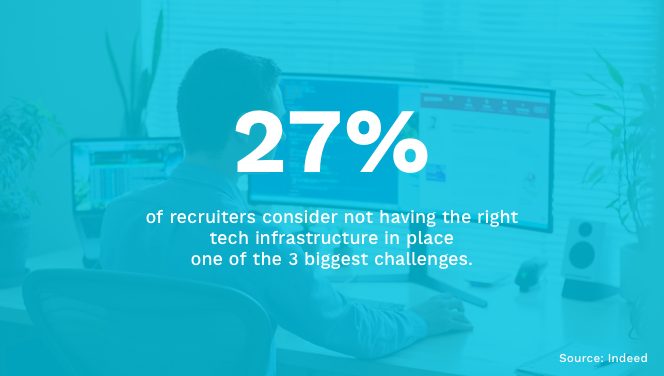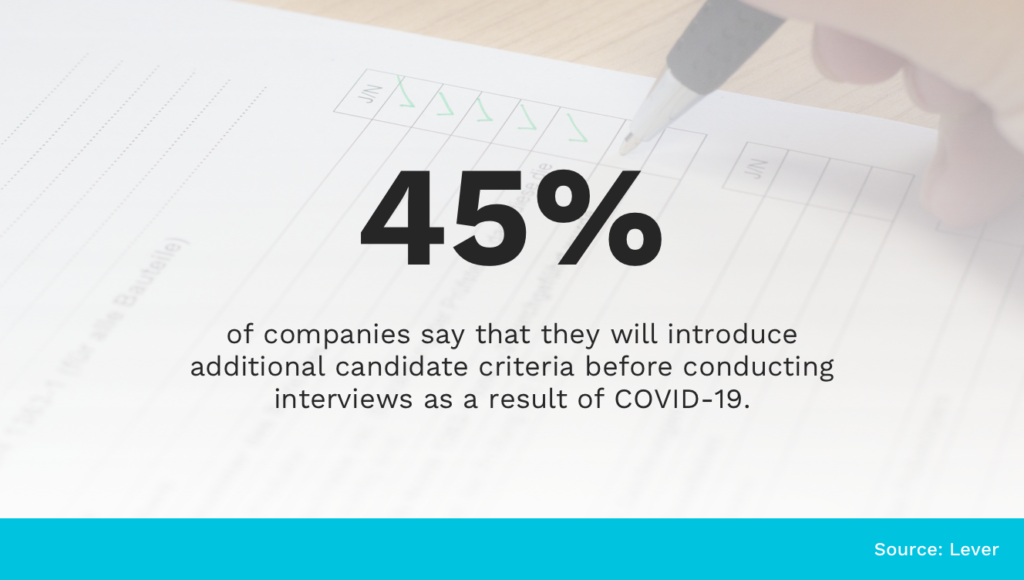There are a lot of metaphors we could use to describe just how difficult it is to find the right person for an open job position.
Like finding a needle in a haystack… like picking a four-leaf clover… You get the picture.
It’s difficult. Especially when you’re frantically combing through applications and resumes trying to locate the perfect candidate within the time and budget restrictions you’ve been given. This kind of searching rarely ends with the right person in the job.
Recruiting the best candidate for your open job depends on having an effective hiring process in place. This is especially true when working within tight timeframes or budgets.
But what does that process look like? We’ve outlined the 9 core elements.
What’s in?
- Clearly defined needs and goals
- Timeline
- Team collaboration
- Application process
- Tech stack
- Structured interview process
- Consistency
- Data
- Fighting bias
Like what you see?
Don’t miss out. Subscribe to our quarterly digest to get the latest TA and TM resources delivered right to your inbox.
1. Clearly defined needs and goals
Whether you’re filling just one position or you’re working to hire hundreds of people, an effective hiring process begins with identifying your needs and establishing clear goals.
Before you post any job listings, think about what you really need from your new hires. What tasks will be expected of them? What skills will each new hire need? What are your non-negotiables and what could you consider hiring without?
Conduct a job tasks analysis to understand the unique requirements of each role. Talk with the people already in that role, or with the supervisors or managers who will work directly with the new hire.
If you’re hiring more than one person, consider the urgency of each role. If filling a specific role is more important to your company’s bottom line, focus on hiring that person first. Don’t overwhelm your team by trying to bring on dozens of new team members at once.
2. Timeline
Do you have a specific date that you need to have this role filled by? Is there a major project coming up that you need this new role for before it starts? If so, having a timeline in place is crucial for ensuring you can find, hire, and onboard the right candidate in time.
To create your timeline, you want to look at your historic data. How long does it usually take you to fill an open role? How many steps are there in your hiring process? Who needs to be involved in hiring and what time restraints do they bring to the equation? What is the most common notice period your candidates have at their current jobs?
A timeline is also helpful in managing expectations. If you know that your typical time-to-hire is around eight weeks, you can let managers and teams know that they shouldn’t anticipate a new person starting Monday. Establishing these timelines ahead of time can improve communication and ensure you’re forecasting appropriately.
Even if you’re not confined to a strict deadline, having a timeline in place is always a good idea. Don’t skip this step if you want to ensure an effective hiring process.

Over 60% of talent professionals admit that their time to hire is longer than 30 days. Setting a timeline and sticking to it has a positive impact on the effectiveness of your hiring process. (Image source)
3. Team collaboration
Bringing a new person onto the team is an all-hands-on-deck experience. If the people who will be most involved in the new role you’re hiring for—meaning the hiring manager, people on the new hire’s team or those who might be working directly with them each day—participate in the hiring process, you have a high chance of bringing the right person on board.
Everyone involved in the hiring process needs to communicate and collaborate regularly. There should be easy ways to discuss needs, share ideas about what the role should look like, and converse about candidates and whether they’re fitting the image you’re looking for.
This is especially important in a remote working environment. When everyone is spread out, communication needs to be even stronger.
Find a collaboration method that works for your team. This might include an instant messaging channel where you can discuss open positions, regular meetings to check-in, or a clear system that allows everyone on the team to keep an eye on how the hiring process is progressing, like ATS notifications.
4. Application process
A difficult or glitchy application can be one of the biggest reasons someone doesn’t apply for a job. They might be perfectly qualified and a great fit for your company, but if it’s too much of a hassle to fill out the application or the process doesn’t work on their device, they’ll just move along to the next one.
Creating a challenging application process only hurts your business in the long run. If you want to get the best candidates, make it easy for them to upload a resume or fill out a form with their important information.
Make sure applications work on mobile devices, including smartphones and tablets, and make sure the software you’re using is clean and user friendly. Run through the process yourself (or better yet, get your team to try it as well) to make sure everything works according to plan.
It also helps to send out a notification that you received the application and include next steps for what they can expect. Not only can this relieve some stress for candidates, but it prevents them from calling or emailing to check-in—saving your team time.
Stop guessing,
Start data-driven hiring.
Learn how you implement a modern candidate selection process, that is: streamlined, experience-driven and backed by data.

5. Tech stack
At the center of every good recruitment tech stack is an applicant tracking system (ATS). This tool helps you keep an eye on everything happening with your applicants, including the job they applied for, where they are in the interview process, and notes about how well they fit (or don’t fit) with your organization.
Having a proper ATS makes it easy for your team to collaborate. When your team isn’t keeping notes on sticky notes, nothing can get lost. And it makes it easy to bring the entire team on board when hiring someone.
But an ATS is just the beginning of a great hiring tech stack. You can build upon it with an assessment suite, matching technology, recruiting chatbots, and more. By implementing these different types of technology and software, you can cut down on the amount of time your team is spending keeping things organized, sending emails, or evaluating assessments—helping you get more done in less time.
Don’t get overwhelmed by all the tech options out there. If you don’t already have an ATS in place, start there. As you get more comfortable and start to recognize your needs, you can focus on building your stack.
Top tip: Get a comprehensive overview of different types of recruiting software here.

A lack of the right tech can really hinder your hiring process, so when you’re building your tech stack, make careful considerations.
6. Structured interview process
The interview process isn’t always as straightforward as we’d like it to be. We meet great candidates at different times, or certain people have crazy schedules that make it difficult for them to be available when you need them.
But when your interview process is a mess, hiring will never be easy. When you’re just connecting with candidates whenever they have a free minute, you’re bound to forget conversations, not follow up, or lose touch with someone completely.
Having a clear structure in place can make the process faster and more efficient, and even help you mitigate against bias. While things might get off track every once in a while, sticking as close as possible to a structure can make your hiring process better.
Make sure that you’re asking the same questions in the same order to all your candidates (for the same role) and that the same people are involved in the interview process.
If different roles require different hiring processes, that’s okay but make it consistent throughout each open position. Figure out a structure that works for you and try to stick as close to it as possible.
7. Consistency
In order to ensure you’re bringing the right person onto your team, you need to make sure you’re evaluating each candidate the same way. If you’re measuring assessments for Candidate A one way, but measuring Candidate B by a different set of standards, you can’t be sure you’re making the right hiring decision.
That’s why consistency is key in an effective hiring process. Knowing what you’re evaluating each candidate on, as well as what your team should be paying attention to, lets you easily compare candidates to see who might be the better fit.
Establish benchmarks for assessment results, use interview scorecards or other evaluation methods that help things stay consistent. Provide your team with the tools they need to make it easy to measure each candidate by the same criteria.
These evaluation points should appear at every stage of the funnel, so include specific details at each level.

Many companies are changing the way they assess candidates. It is essential to ensure that the same criteria apply to all applicants to be able to make consistent hiring decisions.
8. Data
Collecting and using data helps guide your hiring decisions. When you keep track of past hiring processes, including stats about your interview process or information about your candidates, you can create a more effective hiring process by tackling the issues that were holding you back previously.
For example, if you find that you typically have a lot of first-round interviewees but not a lot that you want to move forward with, this might be a sign you’re missing the mark in identifying the right candidates for your job or that you’re putting job listings in the wrong place. Tracking this data, including identifying where your best candidates are coming from, can help you target the right people so you waste less time with people who just don’t fit.
Knowing what data is important to you can be challenging because there is so much you can collect. However, identifying what recruiting KPIs are important to you or where you’re struggling in your hiring process can help guide you.
9. Fighting bias
Fighting bias needs to be engrained in your entire hiring process. It’s not just a step to add to the end. If you don’t put in the work to remove bias at the beginning of your hiring process, as well as at every step throughout, you can’t be sure you’ve created a truly effective funnel.
To fight bias within your hiring process, check for adverse impact to ensure a fair hiring process at each step. Create diverse interview panels, including team members with different backgrounds, opinions, and roles within the organization.
You can also lean heavily on the data you collect. By letting data guide your decisions, rather than personal feelings or opinions, you can feel more confident that bias is reduced in your hiring process.

Asking inappropriate questions leads to bias and discrimination in your hiring process. Continuously reevaluate your hiring process to see if there’s anything problematic that you need to change.
Over to you
Even with these nine pillars of an effective hiring process, there will always be opportunities for improvement. However, setting a strong foundation leads to better, consistent, and fair hiring decisions.
Start by reviewing your current process to identify the inefficiencies and find out which stages need the most attention. That will help you get well on the way to building an effective recruiting process.
Stop guessing,
Start data-driven hiring.
Learn how you implement a modern candidate selection process, that is: streamlined, experience-driven and backed by data.



